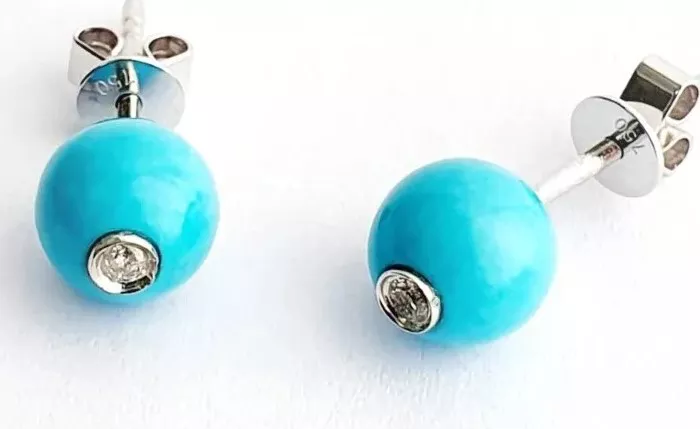Small turquoise stud earrings are a timeless and elegant jewelry choice. They add a pop of color to any outfit while remaining subtle and sophisticated. Whether you wear them daily or for special occasions, these earrings never go out of style.
In this guide, we will explore everything about small turquoise stud earrings. We will discuss their history, types, benefits, how to choose the best pair, and how to care for them.
What Are Turquoise Stud Earrings?
Turquoise stud earrings are small, round, or shaped pieces of jewelry. They feature a turquoise gemstone set in metal. The stone is usually secured with a prong, bezel, or glue setting. Stud earrings sit close to the earlobe, making them comfortable and versatile.
Turquoise is a blue-to-green mineral. Its color comes from copper and iron. The stone has been prized for centuries for its beauty and cultural significance.
The History of Turquoise in Jewelry
Turquoise has been used in jewelry for thousands of years. Ancient Egyptians, Persians, and Native Americans all valued this gemstone.
Ancient Egypt: Turquoise was used in royal jewelry and burial ornaments. It symbolized protection and wealth.
Persian Empire: The finest turquoise came from Iran (formerly Persia). Persian turquoise was known for its pure sky-blue color.
Native American Culture: Tribes like the Navajo and Zuni used turquoise in jewelry and ceremonies. They believed it had healing and protective powers.
Today, turquoise remains a beloved gemstone in modern jewelry. Small stud earrings keep its beauty simple and wearable.
Why Choose Small Turquoise Stud Earrings?
Versatility
These earrings match almost any outfit. They look great with casual, professional, and formal wear.
Timeless Appeal
Turquoise never goes out of fashion. Unlike trendy jewelry, these studs remain stylish for years.
Comfort
Small studs are lightweight. They don’t pull on the earlobes or get caught in hair.
Cultural and Spiritual Meaning
Many people wear turquoise for its believed benefits:
Brings calmness and balance
Protects against negative energy
Promotes good fortune
Affordable Luxury
High-quality turquoise is valuable but not as expensive as diamonds or sapphires. Small studs are an affordable way to own this gemstone.
Types of Small Turquoise Stud Earrings
Natural Turquoise vs. Stabilized Turquoise
Natural Turquoise: Untreated, pure stone. It has a softer texture and may change color over time.
Stabilized Turquoise: Treated with resin to enhance durability and color. More common in jewelry.
Different Settings
Prong Setting: Metal claws hold the stone. Allows more light to shine through the turquoise.
Bezel Setting: A metal rim surrounds the stone. Offers more protection.
Glue Setting: The stone is glued into a metal cup. Common in budget-friendly earrings.
Metal Choices
Sterling Silver: A classic choice that complements turquoise’s cool tones.
Gold (Yellow, White, or Rose): Adds warmth and luxury.
Platinum: Durable and hypoallergenic, but more expensive.
Shapes and Sizes
Round Studs: The most common and traditional.
Oval or Cushion Studs: Slightly elongated for a softer look.
Square or Geometric Studs: Modern and edgy.
How to Choose the Best Small Turquoise Stud Earrings
Check the Quality of the Turquoise
Color: Look for even, vibrant blue or green shades. Avoid dull or patchy stones.
Matrix (Veining): Some turquoise has brown or black veins. This is natural but should not dominate the stone.
Surface: Avoid cracks or pits. A smooth, polished surface is best.
Choose the Right Metal
For a Cool Look: Silver or white gold.
For a Warm Look: Yellow or rose gold.
Consider the Size
Small (2-4mm): Minimalist and subtle.
Medium (5-7mm): More noticeable but still comfortable.
Buy from a Trusted Seller
Avoid fake or dyed stones. Reputable jewelers provide authenticity certificates.
Check reviews and return policies before buying.
How to Wear Small Turquoise Stud Earrings
These earrings are incredibly versatile. Here are some styling tips:
Everyday Wear
Pair them with jeans and a white shirt for a fresh, effortless look.
Wear them to work for a touch of elegance.
Boho and Casual Style
Combine them with flowy dresses, leather bracelets, and layered necklaces.
Formal Occasions
Match them with an evening gown or a sleek suit.
Mix and Match
Wear one turquoise stud and one simple metal stud for an asymmetrical look.
How to Care for Turquoise Stud Earrings
Turquoise is a soft stone (5-6 on the Mohs scale). It needs gentle care to last.
Avoid Water and Chemicals
Remove earrings before swimming, showering, or applying perfume.
Keep them away from cleaning products.
Clean Gently
Use a soft, dry cloth to wipe the stones.
Avoid ultrasonic cleaners or harsh chemicals.
Store Properly
Keep them in a jewelry box or soft pouch to prevent scratches.
Store them separately from harder gemstones like diamonds.
Check the Settings
Over time, prongs or bezels may loosen. Have a jeweler inspect them yearly.
Where to Buy Small Turquoise Stud Earrings
Local Jewelry Stores
You can see the stones in person before buying.
Online Retailers
Etsy, Amazon, and specialty jewelry sites offer many options.
Read reviews and check return policies.
Native American Artisans
Authentic handmade turquoise earrings from Native American artists are unique and meaningful.
Vintage and Antique Shops
Vintage turquoise studs often have unique charm and history.
Conclusion
Small turquoise stud earrings are a perfect blend of beauty, history, and practicality. They suit any style, from casual to formal. Their rich cultural background makes them more than just accessories—they carry meaning and tradition.
When choosing a pair, focus on quality, metal type, and size. Take good care of them to keep their vibrant color and shine. Whether you buy them for yourself or as a gift, these earrings will always be a cherished piece.
Turquoise has been loved for centuries, and small stud earrings keep its legacy alive in modern fashion. If you want a simple yet meaningful jewelry piece, turquoise studs are an excellent choice.
Related topics:
[Revealed!] Is Turquoise Howlite Real Turquoise?
The Color Theory: What is the opposite color of turquoise?
Where does purple copper turquoise come from: A Quick Guide


